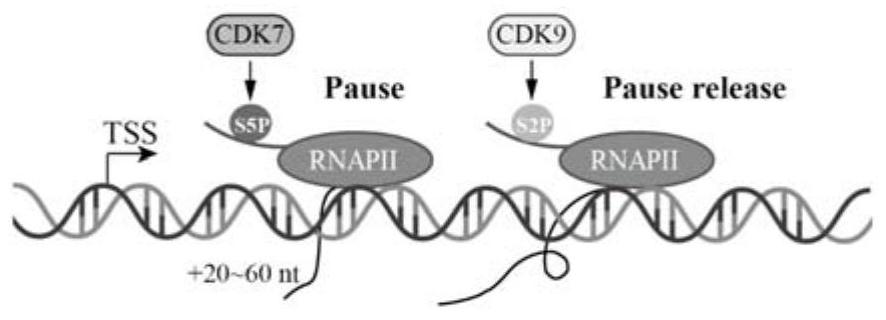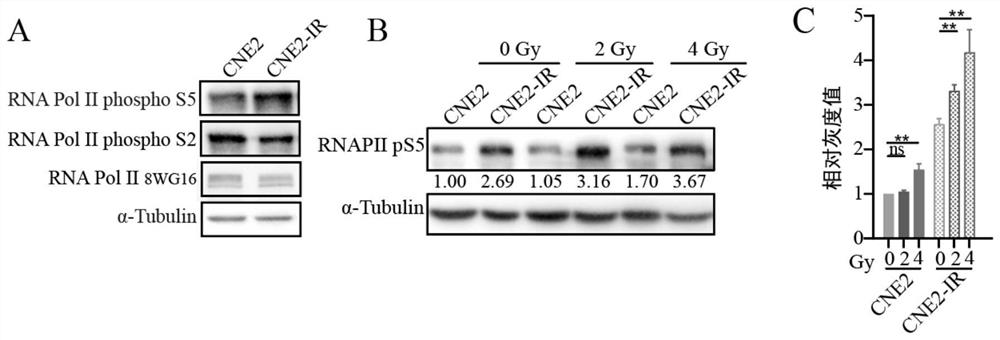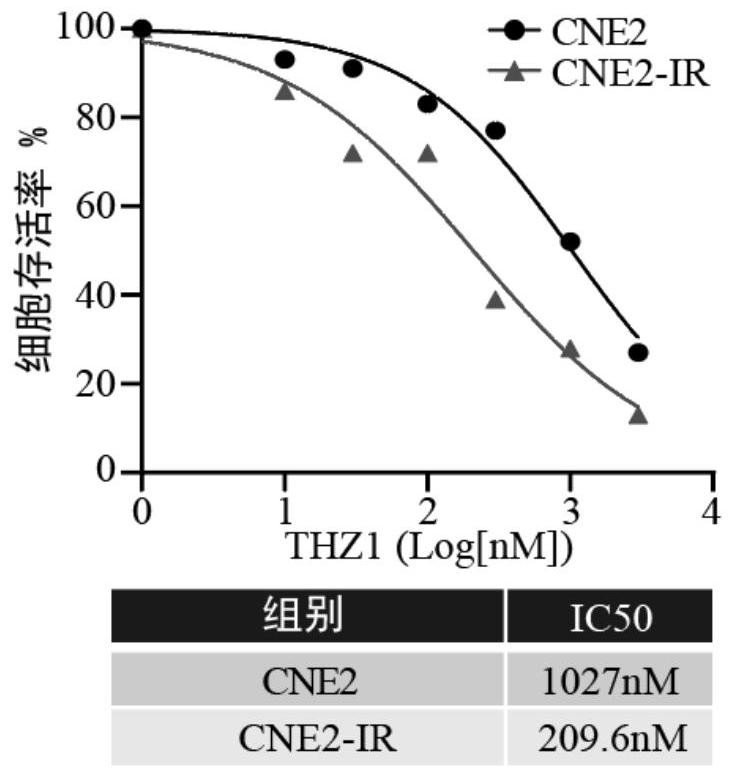Application of CDK7 inhibitor THZ1 in nasopharynx cancer radiotherapy resistance treatment
An inhibitor and nasopharyngeal carcinoma technology, which is applied in the application field of CDK7 inhibitor THZ1 in the radiotherapy resistance of nasopharyngeal carcinoma, can solve the problems of transcriptional changes, unclear effectiveness of radiotherapy, etc., and achieve the goal of increasing radiotherapy sensitivity Effect
- Summary
- Abstract
- Description
- Claims
- Application Information
AI Technical Summary
Problems solved by technology
Method used
Image
Examples
Embodiment 1
[0040] The phosphorylation level of RNAPII CTD is different in nasopharyngeal carcinoma radiosensitive and resistant cells.
[0041] According to this example, it can be known that there is a difference in the phosphorylation of RNA polymerase II Ser5 in nasopharyngeal carcinoma radiotherapy-sensitive cells and radiotherapy-resistant cells.
[0042] (1) Materials and reagents:
[0043] Purchase the basal medium and serum as shown in the table below, and prepare according to the ratio of 10% FBS for culturing CNE2 and CNE2-IR cells. Cell lysates were used to collect proteins for Western blotting.
[0044]
[0045] (2) Experimental steps
[0046] 1) Collect protein
[0047] Will 4×10 5 Plate cells into 6-well plates at 37 °C and 5% CO 2 Incubate in the environment for 24 hours. Remove the medium, rinse the cells with buffer DPBS 3 times, add 200μl cell lysate (2% SDS, 10% glycerol, 62.5mM Tris-HCl pH6.8; add 1× protease inhibitor cocktail, 10mM sodium fluoride, 1mM Sod...
Embodiment 2
[0072] CNE2 and CNE2-IR differ in sensitivity to the CDK7 inhibitor THZ1.
[0073] (1) Materials and reagents:
[0074] Purchase the following reagents.
[0075]
[0076] (2) Experimental steps
[0077] 1) Drug treatment
[0078] Step 1: Take a 10cm culture dish as an example, digest logarithmic cells with 1ml trypsin, centrifuge to collect after termination of digestion, resuspend into a cell suspension with phenol red-free DMEM medium, count, and count according to 1000 CNE2 per well Cells and 1200 CNE2-IR cells per well, after calculation, take an appropriate amount of cells and plate them in a 96-well plate (the edge wells are filled with sterile PBS), and set more than three replicate wells for each drug concentration. Reserve three duplicate wells and only add the same amount of culture medium as the background, and culture in an environment of 37°C and 5% CO2 until the cell monolayer covers the bottom of the well.
[0079] Step 2: Dissolve the drug in 10% DMSO DP...
Embodiment 3
[0088] The combined effect of radiotherapy exposure and THZ1 on growth proliferation of CNE2 and CNE2-IR.
[0089] (1) Reagents and materials:
[0090] Refer to Example 2.
[0091] (2) Experimental steps:
[0092] 1) Drug treatment
[0093] Taking CNE2 as an example, spread 4×105 cells per well into 2 wells of a 6-well plate, spread 2 pieces, and culture them in an environment of 37°C and 5% CO2 until the cells adhere to the wall. Dissolve the drug in 10% DMSO in DPBS buffer, add THZ1 with a final concentration of 150nM to each plate, and 0μM solvent without THZ1, the final concentration of DMSO in each well is less than 0.2%, put it at 37°C and 5% CO2 environment for 12 hours.
[0094] 2) Ionizing radiation
[0095] Take one of the 6-well plates, and use a linear accelerator (X-Rad 225, Precision) to irradiate with a dose of 2Gy at room temperature and 200cGy / min. The CNE2 cells of the control group (solvent, 0Gy) and the experimental group (drug, 0Gy; solvent, 2Gy; dru...
PUM
 Login to View More
Login to View More Abstract
Description
Claims
Application Information
 Login to View More
Login to View More - R&D
- Intellectual Property
- Life Sciences
- Materials
- Tech Scout
- Unparalleled Data Quality
- Higher Quality Content
- 60% Fewer Hallucinations
Browse by: Latest US Patents, China's latest patents, Technical Efficacy Thesaurus, Application Domain, Technology Topic, Popular Technical Reports.
© 2025 PatSnap. All rights reserved.Legal|Privacy policy|Modern Slavery Act Transparency Statement|Sitemap|About US| Contact US: help@patsnap.com



